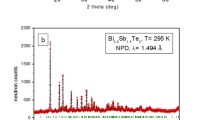Abstract
The core–shell heterostructured Bi2Te3@Sb2Te3 hexagonal nanoplates with a thickness range of 22–26 nm were fabricated by a ligand auxiliary solution process. After complete ligand removal by a facile NH3-based procedure, the platelets are spark plasma-sintered to a good p-type nanostructured bulk material with crystal grain sizes preserved. Resultant crystal structures and microstructures were characterized by means of X-ray diffraction, scanning electron microscopy, transmission electron microscopy, high-resolution TEM, energy dispersed X-ray spectroscopy, selected area electron diffraction, and atomic force microscopy measurements. The influences of solvent ratios of H2O/ethylene glycol, molar concentration of source materials, and PVP on the formation of the core–shell structures were studied in detail. Based on the time-dependent experiment, a possible formation mechanism related to epitaxial attachment was presented for the growth of the core–shell heterostructured Bi2Te3@Sb2Te3 nanoplates. The thermoelectric Seebeck coefficient, S, is in the range of 133–171 μV K−1 and the electric conductivity for the Bi2Te3@Sb2Te3 is in the range of 48,400–79,200 S m−1. The final power factor is in the range of 0.97–2.04 mW m−1 K−2, which is close to those of physical method synthesized bulk pellets. Furthermore, this result is about several to tens of times higher than those of the recent reported works on chemically synthesized nanocrystalline pnictogen chalcogenide materials. These unique features of our core–shell nanoplates make them attractive for the manufacture of high-performance 3D-embedded matrixthermoelectric materials.
Graphical Abstract










Similar content being viewed by others
References
Dirmyer MR, Martin J, Nolas GS, Sen A, Badding JV (2009) Thermal and electrical conductivity of size-tuned bismuth telluride nanoparticles. Small 5(8):933–937
Dou XC, Li GH, Lei HC (2008) Kinetic versus thermodynamic control over growth process of electrodeposited Bi/BiSb superlattice nanowires. Nano Lett 8(5):1286–1290
Dresselhaus MS, Chen G, Tang MY, Yang RG, Lee H, Wang DZ, Ren ZF, Fleurial JP, Gogna P (2007) New directions for low-dimensional thermoelectric materials. Adv Mater 19(8):1043–1053
Goldsmid HJ (1958) The electrical conductivity and thermoelectric power of bismuth telluride. Proc Phys Soc 71:633–646
Hamdou B, Kimling J, Dorn A, Pippel E, Rostek R, Woias P, Nielsch K (2013) Thermoelectric characterization of bismuth telluride nanowires, synthesized via catalytic growth and post-annealing. Adv Mater 25(2):239–244
Li L, Yang YW, Huang XH, Li GH, Ang R, Zhang LD (2006) Fabrication and electronic transport properties of Bi nanotube arrays. Appl Phys Lett 88(10):103119-1–103119-3
Lin YM, Dresselhaus MS (2003) Thermoelectric properties of superlattice nanowires. Phys Rev B 68:075304-1–075304-14
Minnich AJ, Dresselhaus MS, Ren ZF, Chen G (2009) Bulk nanostructured thermoelectric materials: current research and future prospects. Energy Environ Sci 2:466–479
Tsuji M, Yamaguchi D, Matsunaga M, Ikedo K (2011) Epitaxial growth of Au@Ni core–shell nanocrystals prepared using a two-step reduction method. Cryst Growth Des 11(5):1995–2005
Vining CB (2009) An inconvenient truth about thermoelectrics. Nat Mater 8:83–85
Wang W, Zhang GQ, Li XG (2008) Manipulating growth of thermoelectric Bi2Te3/Sb multilayered nanowire arrays. J Phys Chem C 112(39):15190–15194
Yang DC, Meng GW, Xu QL, Han FM, Kong MG, Zhang LD (2008) Electronic transport behavior of bismuth nanotubes with a predesigned wall thickness. J Phys Chem C 112(23):8614–8616
Yang J, Yip H-L, Jen AK-Y (2013) Rational design of advanced thermoelectric materials. Adv Energy Mater 3:549–565
Yao M, Chen W, Fan X, Liu C, Meng X, Guo L, Chen C (2011) Wet chemical synthesis and magnetic properties of core–shell nanocolumns of Ni(OH)2@Co(OH)2 and their oxides. Cryst Eng Comm 13:2593–2598
Yoo B, Xiao F, Bozhilov KN, Herman J, Ryan MA, Myung NV (2007) Electrodeposition of thermoelectric superlattice nanowires. Adv Mater 19:296–299
Zebarjadi M, Esfarjani K, Dresselhaus MS, Ren ZF, Chen G (2012) Perspectives on thermoelectrics: from fundamentals to device applications. Energy Environ Sci 5:5147–5162
Zhang GQ, Wang W, Li XG (2008) Enhanced thermoelectric properties of core/shell heterostructure nanowire composites. Adv Mater 20(19):3654–3656
Zhang G, Yu Q, Wang W, Li X (2010) Nanostructures for thermoelectric applications: synthesis, growth mechanism, and property studies. Adv Mater 22(17):1959–1962
Zhao YX, Dyck JS, Hernandez BM, Burda C (2010) Enhancing thermoelectric performance of ternary nanocrystals through adjusting carrier concentration. J Am Chem Soc 132(14):4982–4983
Zhao Y, Dyck JS, Burda C (2011) Toward high-performance nanostructured thermoelectric materials: the progress of bottom–up solution chemistry approaches. J Mater Chem 21:17049–17058
Acknowledgments
The study was supported by the State Key Development Program for Basic Research of China (Grant No. 2012CB933200), the National Natural Science Foundation of China (Nos. 51172008 and 51002006), the National natural science fund innovation group (No. 50921003), Beijing Technology Topic Program (No. Z111100066511009), the Research Fund for Doctor Station Sponsored by the Ministry of Education of China (20111102110035), and the Fundamental Research Funds for the Central Universities.
Author information
Authors and Affiliations
Corresponding author
Electronic supplementary material
Below is the link to the electronic supplementary material.
Rights and permissions
About this article
Cite this article
Liang, LX., Deng, Y., Wang, Y. et al. Epitaxial formation of core–shell heterostructured Bi2Te3@Sb2Te3 hexagonal nanoplates. J Nanopart Res 16, 2138 (2014). https://doi.org/10.1007/s11051-013-2138-8
Received:
Accepted:
Published:
DOI: https://doi.org/10.1007/s11051-013-2138-8




